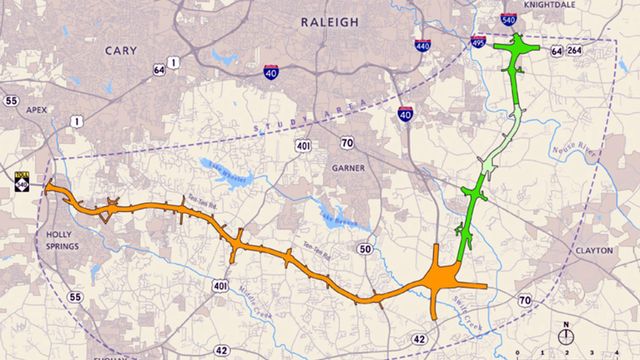DOT steers clear of 'red route' in final NC 540 plan, favors orange and green
The Department of Transportation is recommending a route for the final segment of the N.C. Highway 540 toll road across southern and southeastern Wake County that doesn't include the reviled "red route" proposal that would have cut through the middle of Garner. Instead, the preferred corridor will cut south and east of town, using the proposed orange, green and mint routes.
Posted — UpdatedThe Department of Transportation is recommending a route for the final segment of the N.C. Highway 540 toll road across southern and southeastern Wake County that doesn't include the reviled "red route" proposal that would have cut through the middle of Garner. Instead, the preferred corridor will cut south and east of town, using the proposed orange, green and mint routes.
DOT officials said in a statement that they chose that route to minimize the number of homes and businesses that will be affected; to avoid impacts to the Swift Creek Watershed critical area, which is a source for Raleigh’s drinking water; to bypass the Clemmons Educational State Forest; and to limit the impact to historic resources and area parks.
"There's not a single alternative that would have the least impact on all of the issues that we investigate for projects," said Eric Midkiff, project manager for N.C. 540, noting that the orange route crosses wetlands and could affect an endangered species of mussel. "We try to best balance those impacts when making a decision, and I think the recommended route does that."
The orange route has been DOT's preference since planning for the highway started two decades ago, but environmental concerns forced officials draw its map of many-hued alternatives for study and consideration. Area property owners complained that DOT's slow process prevented them from selling or improving homes and farms.
Kristen Valus learned only after she bought a home in Holly Springs that it sat along the "purple route" for N.C. 540, so she couldn't fix it up.
"We knew we wouldn’t get the money back out of it if they took our home, so we couldn’t risk sinking money into the house," Valus said. "We were like, 'Ugh, handcuffed,' but (lately) we’ve been very excited. Maybe we can get a roof now if it doesn’t snow on us again."
Banks Stephens said he built a house in 1996 along the orange route that will now likely be torn down.
"I kind of always figured it would be the orange route because it’s the least destructive as far as houses and stuff," Stephens said. "What do you do?"
The Southern Environmental Law Center criticized the DOT's recommendation, which comes only a month after public hearings were held.
"We’re extremely disappointed to see NCDOT move forward with this $2 billion toll road, which will devastate the natural environment and strip North Carolina of financial resources desperately needed for other transportation improvements. We remain convinced that there are better solutions to improve traffic in southeastern Wake County that would benefit all drivers – not just those willing and able to pay a pricey toll," SELC attorney Kym Hunter said.
"We remain convinced that there is no legal path forward for the orange route, and NCDOT has long been on notice of the legal obstacles that selection of that route will set in place," Hunter said.
Midkiff said the DOT has been working with the U.S. Fish and Wildlife Service to develop conservation measures for the endangered mussels in order to ease environmental concerns.
The orange-green-mint route would affect 271 homes and 10 businesses and nonprofit groups, which is "substantially fewer" than other possible routes, he said. The number could drop once design plans are finalized, he said.
DOT officials also noted that route is backed by all local governments.
State lawmakers in 2011 passed legislation to prohibit the DOT from even studying the red route, but federal transportation officials said North Carolina couldn't receive any federal funding for the toll road if the route wasn't included in environmental studies. With the highway project stalled, lawmakers repealed the red route ban in 2013.
"I've been mayor for 10 years, and most of that time, I've been consumed by this. I've lost a lot of sleep," Garner Mayor Ronnie Williams said Wednesday. "Now that the red is out of the way, we’re going to keep moving, keep growing."
DOT has dubbed the $2.18 billion toll road project, which will eventually run from N.C. Highway 55 Bypass in Apex to U.S. Highway 64/264 Bypass in Knightdale, Complete 540 because it would finish the loop highway around Wake County.
Federal highway officials still need to provide feedback on the DOT's recommendation, and final environmental and design studies must be completed. Midkiff said the DOT expects to start construction on the leg between N.C. 55 and U.S. Highway 401 late next year or in early 2018.
Construction on the leg from U.S. 401 to Interstate 40 could start in 2024, and the final leg, from I-40 to U.S. 64/264 is still beyond DOT's 10-year schedule, he said.
• Credits
Copyright 2024 by Capitol Broadcasting Company. All rights reserved. This material may not be published, broadcast, rewritten or redistributed.





